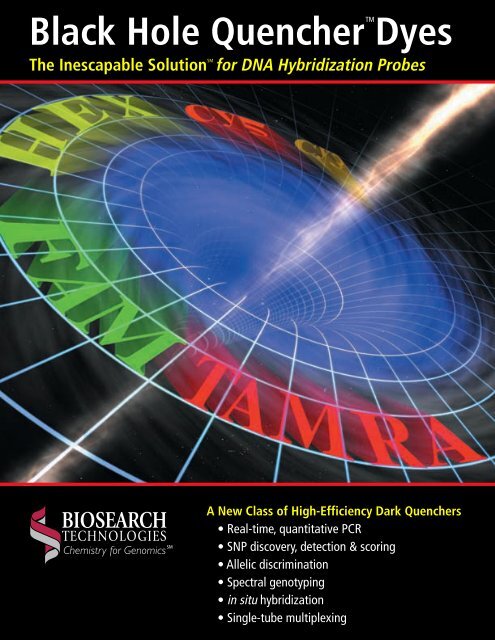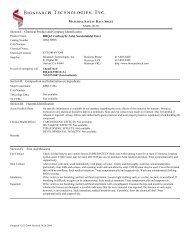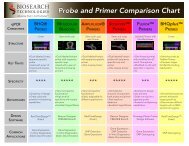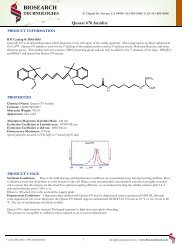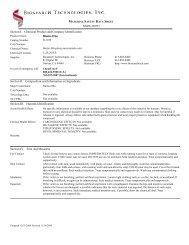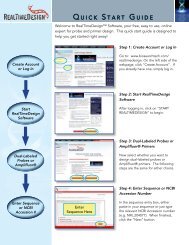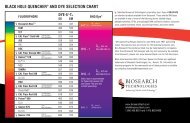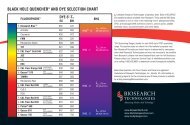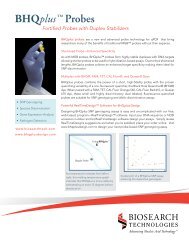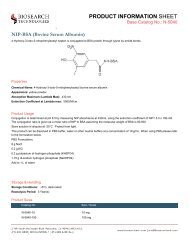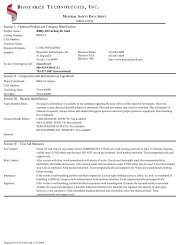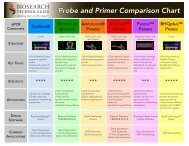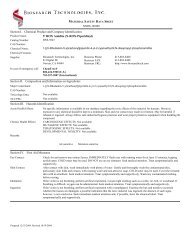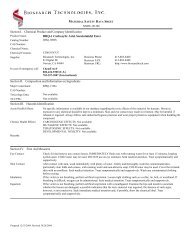Black Hole Quencher Dyes - Biosearch Technologies
Black Hole Quencher Dyes - Biosearch Technologies
Black Hole Quencher Dyes - Biosearch Technologies
Create successful ePaper yourself
Turn your PDF publications into a flip-book with our unique Google optimized e-Paper software.
<strong>Black</strong> <strong>Hole</strong> <strong>Quencher</strong><br />
TM<br />
<strong>Dyes</strong><br />
SM<br />
The Inescapable Solution for DNA Hybridization Probes<br />
SM<br />
A New Class of High-Efficiency Dark <strong>Quencher</strong>s<br />
• Real-time, quantitative PCR<br />
• SNP discovery, detection & scoring<br />
• Allelic discrimination<br />
• Spectral genotyping<br />
• in situ hybridization<br />
• Single-tube multiplexing
They’re Here!<br />
<strong>Black</strong> <strong>Hole</strong> <strong>Quencher</strong>s<br />
• A NEW class of high-efficiency<br />
dark quenchers<br />
• Optimized for FRET — by design<br />
• <strong>Dyes</strong> that really go the distance<br />
• DABCYL eclipsed by BHQ dyes<br />
• TRUE dark quenchers — NO<br />
native fluorescence<br />
• Access visible into near-IR spectrum<br />
for reporting — 480 to 730 nm<br />
• Enable wider choice of reporter dyes<br />
for multiplexing<br />
• Wide variety of probe formulations<br />
A NEW class of highefficiency<br />
dark<br />
quenchers<br />
Custom-synthesized hybridization<br />
probes incorporate<br />
spectrally paired fluorophores<br />
and quenchers, each covalently<br />
linked to minimize interference<br />
with probe-target hybridization.<br />
The BHQ dyes are a new class of<br />
high-efficiency dark quenchers<br />
that prevent fluorescence until a<br />
hybridization event occurs. These<br />
powerful and highly specific<br />
dyes enable the identification<br />
and quantification of a variety of<br />
biomolecules.<br />
Optimized for FRET— by design!<br />
Hybridization probes are designed to take advantage of quenching by<br />
fluorescence resonance energy transfer (FRET) to detect and report binding<br />
to target molecules.<br />
Figure 2 The FRET Process.<br />
Figure 1 Hybridization event turns on<br />
fluorescence. BHQ dyes are compatible<br />
with linear probes and beacons on any<br />
real-time Q-PCR platform or end-point<br />
fluorescent plate reader.<br />
FRET is a highly distance-dependent interaction between a reporter dye in<br />
an excited state and a quencher in its ground state. Energy is transferred from<br />
one molecule (the fluorophore) to the other (the quencher) without the<br />
emission of a photon.<br />
In order for efficient FRET quenching to take place: a) the fluorophore and<br />
quencher molecules must be close to each other (approx. 10 - 100 Å) and,<br />
b) the absorption spectrum of the quencher must overlap with the emission<br />
spectrum of the fluorophore.<br />
Figure 3 Spectral overlap of BHQ-2 dye with TAMRA and ROX.<br />
Each member of the family of BHQ dyes was conceived and<br />
designed to maximize spectral overlap, thus increasing the<br />
efficiency of quenching.
<strong>Dyes</strong> that really go the distance<br />
FRET quenching efficiency depends on 1/r 6 where r is the dye-quencher<br />
distance. In solution, unhybridized FRET probes are posited to exist as random<br />
coils allowing the reporter and quencher dyes to remain in close proximity<br />
favoring FRET quenching. Upon hybridization to a complementary target, the<br />
probe is stretched out of its random coil configuration. Thus, the reporter and<br />
quencher are separated and increased fluorescence results.<br />
The efficiency of FRET is given by:<br />
6 6 6 E = R /(R0 +r ) where R0 = Förster distance<br />
0<br />
r = donor-quencher distance<br />
R 0<br />
6 ∝QD and J where Q D = donor fluorescence efficiency<br />
J = overlap integral<br />
DABCYL eclipsed by BHQ dyes<br />
Quenching efficiency increases as spectral overlap J of the dye emission and<br />
quencher absorption profile increases. Historically, DABCYL has been<br />
routinely used as a general-purpose dark quencher for many commonly<br />
used fluorophores including FAM, TET, and JOE. As shown in Figure 4,<br />
however, DABCYL’s absorption maximum of 474 nm places it below the<br />
maxima of the shown fluorophores, limiting its efficiency to quench via<br />
FRET. The BHQ-1 dye (with an absorption maximum of 534 nm) is above<br />
DABCYL and directly superimposable with emission maxima of FAM, TET<br />
and JOE, providing a significant increase in FRET quenching efficiency.<br />
Figure 4 Absorption spectra of DABCYL-T9 and BHQ-1-T9 with the emission spectra of<br />
FAM, TET and JOE. DABCYL and BHQ-1 dye were normalized at the poly-T absorbance (i.e.<br />
260 nm) to better demonstrate the larger extinction coefficient of the BHQ-1 dye.<br />
RFU=relative fluorescence units.<br />
True dark quenchers — NO native fluorescence<br />
The two most commonly used quenchers, DABCYL and TAMRA, both limit the<br />
ultimate sensitivity and flexibility of FRET assays. DABCYL has an inadequate<br />
absorption footprint that overlaps very poorly with fluorophores emitting<br />
above 480 nm. TAMRA is not a dark quencher and contributes to an overall<br />
increase in background because of its own native fluorescence. As shown in<br />
Figure 5, each of the BHQ dye probes have much larger signal-to-noise ratios<br />
when compared to the corresponding DABCYL and TAMRA probes.<br />
Figure 5 Signal-to-noise (S:N) ratios were calculated by dividing the fluorescence<br />
signal of a 25-mer in the presence of a five-fold excess of an exactly complementary<br />
target sequence by the fluorescence intensity of the probe alone. Each probe was<br />
formulated with a 5’ reporter group (FAM, Cy3, Cy5) and a quencher (TAMRA, DABCYL,<br />
BHQ-1, BHQ-2 or BHQ-3).<br />
Access the visible spectrum and near-IR for<br />
reporting — 480 to 730 nm<br />
The BHQ family of quenchers was developed to provide excellent spectral<br />
overlap over the entire range of commonly used reporter dyes. As shown in<br />
Figure 6, the BHQ dyes cover the spectrum from 480 nm into the near IR<br />
making it possible to utilize reporter dyes that emit anywhere in this range.<br />
Figure 6 Absorbtion spectra of the three BHQ dyes (conjugated to T-9 and normalized to<br />
the poly-T absorbance of 260 nm) with the emission maxima of many commonly used<br />
reporter groups indicated.
Enable wider choice of reporter dyes for multiplexing<br />
As detection instrumentation has become more sophisticated, the ability to<br />
multiplex several fluorophores in a single reaction tube has gained much<br />
interest. One of the major drawbacks in any FRET-based multiplexing assay is<br />
cross-talk between the fluorophores, which hampers the ability to distinguish<br />
between dyes. Historically, this drawback has resulted from an absence of<br />
quenchers able to effectively quench throughout the visible and near-IR<br />
spectra. As shown in Figure 7, the BHQ family readily permits single-tube<br />
multiplexing due to the increased variety of reporter dyes that can be<br />
effectively quenched with little or no cross-talk between reporters. The<br />
broader spectral coverage of the BHQ dyes provides the scientist with a larger<br />
pool of distinct, spectrally resolved reporter dyes which simplifies the design,<br />
implementation and interpretation of multiplexed hybridization probe assays.<br />
Figure 7 The unique characteristics of the BHQ class of quenchers permits flexibility in<br />
the choice of spectrally well-resolved fluorophores enabling single-tube multiplexing with<br />
little or no cross-talk.<br />
Wide variety of probe formulations<br />
<strong>Biosearch</strong> can incorporate BHQ dyes into almost any probe formulation: from<br />
linear DNA probes to molecular beacons. In addition, we have developed<br />
functionalized BHQ dyes for internal modifications. We would be pleased to<br />
work with you to design BHQ probes specific for your application!<br />
SM<br />
References<br />
Haugland, R.P., Yguerabide, J., Stryer, L. Proc. Natl. Acad. Sci. USA, 1969, 63:23-30.<br />
Parkhurst, K.M., Parkhurst, L.J. Biochemistry, 1995, 34:293-300.<br />
Parkhurst, K.M., Parkhurst, L.J. Biochemistry, 1995, 34:285-292.<br />
Tyagi, S., Bratu, D.P. & Kramer, F.R. Nature Biotechnology, 1998, 16:49-53.<br />
If you have questions about any <strong>Biosearch</strong> product, please contact <strong>Biosearch</strong><br />
via email at info@biosearchtech.com or via phone in the U.S. at<br />
1.800.GENOME.1 (1.800.436.6631) or +1.415.883.8400 world-wide.<br />
Corporate Headquarters<br />
81 Digital Drive<br />
Novato, CA 94949-5750 USA<br />
Phone: +1.415.883.8400<br />
USA Only: 1.800.GENOME.1 (1.800.436.6631)<br />
Fax: +1.415.883.8488<br />
info@biosearchtech.com<br />
www.biosearchtech.com<br />
BHQ dyes function as efficient dark quenchers over the entire visible<br />
spectrum and into the near-IR, re-emitting their energy as heat rather than<br />
light. Probes made with BHQ dyes exhibit extremely low background<br />
fluorescence, enabling enhanced detection sensitivity.<br />
BHQ Dye Absorption Maxima and Quenching Range<br />
<strong>Quencher</strong> Abs max Quenching Range (nm)<br />
BHQ-1 534 480 – 580<br />
BHQ-2 579 550 – 650<br />
BHQ-3 672 620 – 730<br />
BHQ Dye / Reporter Combinations<br />
<strong>Quencher</strong> Suggested Fluorophores<br />
BHQ-1 FAM, TET, JOE, HEX, Oregon Green ®<br />
BHQ-2 TAMRA, ROX, Cy3, Cy3.5, CAL Red , Red 640<br />
BHQ-3 Cy5, Cy5.5<br />
For Research Use Only. Not for use in diagnostic procedures.<br />
”<strong>Black</strong> <strong>Hole</strong> <strong>Quencher</strong>”, ”BHQ“ and “CAL Red” are trademarks of <strong>Biosearch</strong><br />
<strong>Technologies</strong>, Inc. ”The Inescapable Solution“ and ”Chemistry for Genomics“ are<br />
servicemarks of <strong>Biosearch</strong> <strong>Technologies</strong>, Inc. BHQ technology is covered by patents<br />
applied for by <strong>Biosearch</strong> <strong>Technologies</strong>, Inc. Oregon Green is a trademark of<br />
Molecular Probes, Inc. ©2001 <strong>Biosearch</strong> <strong>Technologies</strong>, Inc. All rights reserved.<br />
Information subject to change without notice.<br />
<strong>Biosearch</strong> <strong>Technologies</strong> is a leading supplier of<br />
custom reagents, synthesis supports and specialty<br />
chemicals for genomics & proteomics R&D to<br />
customers in the pharmacogenomic, drug<br />
discovery and basic life science research markets.


